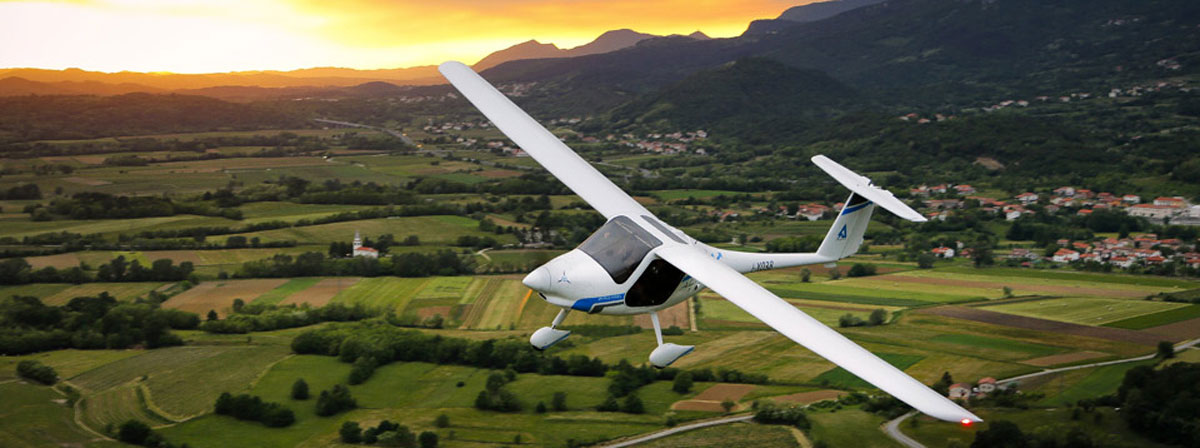If it were up to Elon Musk, everyone would be driving electric-powered vehicles. Unless you live in a remote part of the world, you probably see more and more Tesla’s and alternative powered cars, but what about Aircraft? Are they also transitioning to alternative powerplants?
With global warming on the rise, electric powered planes are growing in demand for sustainable air travel. Let’s take a look at what we know so far about these planes and how they’ll impact our future.
Let’s get started!
Pipistrel Alpha Electro
The Alpha Electro has optimized traffic-pattern operations, where 13% of energy is recuperated on every approach, increasing endurance and at the same time enabling short-field landings.
The new ALPHA Electro is an aircraft which is affordable to acquire, it is economical to maintain and we believe no other LSA training aircraft is as cheap to run as the new Pipistrel ALPHA Electro with its frugal operating costs, in most areas it could be as little as $3/hour for electricity to operate the aircraft.
Pipistrel is the leading light aircraft manufacturer established in Europe for over 25 years, winner of the world air games, and winner of the NASA CAFE challenge three times in a row (including winner of $1.375 Million – the largest prize ever awarded for efficiency in flight).
With the trainer market being the best performing residual values in the entire aviation market, it makes sense to check out this fantastic new aircraft.
NASA’s Electric Airplane
The National Aeronautics & Space Administration (NASA) is preparing to test its first electric plane, called X-57 Maxwell.
The aircraft’s latest version is known as Mod II, short for Modification II. Empirical Systems Aerospace developed it in California’s city of San Luis Obispo.
In Mod II, you won’t find a traditional airplane combustion engine. Instead, you’ll find an eclectic powerplant. Battery power will enable NASA to engage in test flights with this experimental aircraft.
In future versions of the plane, which will be called Mod III and Mod IV, NASA developers will continue to develop the aircraft and perform final tests, which includes testing the wings.
Emissions associated with jet fuel remain a top contributor to the greenhouse gas issue impacting the earth.
In light of this, NASA’s main goal with its first electric aircraft is to reduce flights’ carbon footprints.
Can Electric Energy Planes Resolve the Emissions Issue? Maybe
As a general rule of thumb, long-haul passenger aircraft that are fueled by electricity still have a ways to go when it comes to their range. We just crossed the 80-minute mark, and if Tesla is any indicator, we should start seeing these numbers double and even triple in the coming years. VREF’s new platform was built to be able to track alternative power plants, so stay tuned for more data from VREF.
Significant funding and research must be devoted to these flights’ capacity to reach that of flights fueled by fossil fuels.
Another challenge that we continue to face when it comes to electric energy planes is that Investors are a bit reluctant to commit to research on electrical energy planes fully.
So, why is this?
Because no comprehensive and binding international agreement aimed at reducing air travel emissions currently exists.
However, there is still hope that the global community can come together to make such an agreement happen.
It is paramount that decision-makers across the globe get serious about creating an appropriate political framework for facilitating a decrease in aviation emissions. Electric-powered aircraft can help us to resolve our greenhouse gas issues in the years and decades ahead.
How We Can Help
In addition to providing the latest on electric energy planes, we offer the most updated engine and aircraft data. You can access this information via our quarterly digests and digital subscription services.
We furthermore provide a litigation consulting service along with valuations and appraisals to clients all over the world. We take pride in advising key decision-makers in today’s dynamic aviation industry.
Get in touch with us to learn more about how our many services can help you to make the most of today’s quickly changing aviation industry both now and in the future.




